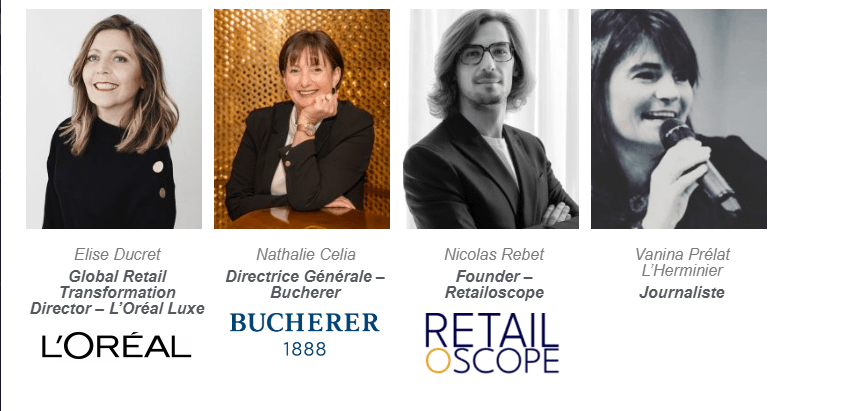At the round table organized as part of Tech for Retail 2024, the speakers below explored the evolving customer experience in the luxury sector.
They highlighted the importance of hospitality, the return to strengthened human relations, and the role of AI in a demanding sector.

An experience that goes hand in hand with the product
In the world of luxury, the customer experience is inseparable from the product, which relies on excellence of design on the one hand, and a carefully orchestrated in-store experience on the other. Boutiques, which have become places of singularity and culture, now adapt to local specificities by collaborating with artists or integrating regional cultural elements. This personalization contributes to enriching a customer experience that is not limited to purchasing, but seeks to seduce the senses and arouse lasting emotion.
The experiential society and the battle for attention
In a society where attention is a scarce resource, the battle for customer loyalty is crucial. In the luxury sector, losing one customer can mean having to win over ten to make up for the loss. Consumers' quest for recognition and identification drives brands to offer new and memorable experiences, where every detail counts. The beauty industry is a good example of this trend towards a service economy. For example, L'Oréal Luxe has integrated innovative concepts such as a café designed by Nina Métayer in the Lancôme flagship on the Champs-Élysées, or the Prada Café in collaboration with Harrods. These initiatives transform sales areas into living spaces, where simplicity and exclusivity meet.
The duality of luxury: ultra-luxury and massification
Two major trends are shaping the customer experience: an ultra-luxury segment, aimed at a restricted and demanding clientele, and a massification of luxury, making it accessible to a wider public while maintaining high standards. In the ultra-luxury segment, brands compete in creativity to offer exceptional moments: a cheese platter tailored to the customer's tastes on arrival at Bucherer, driving courses on ice, the privatization of the Tower of London for a jewelry event, or exclusive meetings with Le Mans 24 Hours drivers. These experiences create both a "wow" effect and a sense of belonging to a privileged community.

Create a community and extend the experience
The stores themselves have evolved. They now include furnished areas with sofas and sales assistants whose outfits are personalized to reflect the identity of the house. The environment plays a major role: light, music and even scents all contribute to immersion. Houses work on the five senses to transform the visit into an unforgettable moment. Equally crucial is the commitment of the teams, particularly their ability to recognize and individualize interactions with each customer. This personalization, combined with ongoing training, enables us to meet the expectations ofan increasingly well-informed clientele.
The figures speak for themselves: today, 4% of customers generate 40% of a brand's sales (the VICs), and some fine jewelry houses have just ten key customers in their portfolio. However, to secure the remaining 60% of sales, brands need to broaden their strategy to a wider customer base while maintaining quality experiences. By 2024, a global loss of 50 million customers has been observed in the sector, largely due to a decorrelation between the price paid and the perceived value of products.
To meet these challenges, brands are investing in unique collaborations and incorporating hospitality codes. Like Lancôme's private beauty apartment with a top chef, concierges at store entrances welcome customers.
Omnichannel and technology: the 360° experience
The number of points of contact between brands and their customers is multiplying, driven by a strategy Omnichannel that favors an "omni one-to-one" relationship. Artificial intelligence plays a key role in this transformation, notably through clienteling tools and personalized point-of-sale diagnostics. These technologies enrich the customer experience while streamlining the customer journey. An analysis by Bain & Comité Colbert reveals that 75% of home customers are open to a digital experience, a technological application but not in their hands. Laurence Bommer said, "the digital experience becomes acceptable if we accompany the customer and if the salesperson marvels with him". Technology must remain a facilitator, not a substitute, because the human element remains the key to the luxury experience.
Thanks to digital tools, sales staff can anticipate visits and the overall environment is redesigned to reflect excellence. L'Oréal Luxe, for example, uses Beauty Tech not only to personalize the customer experience, but also to optimize assortments and back-office inventories. Sales teams play a fundamental role in the success of this experience Omnichannel. Recruiting and training salespeople adapted to VIC or consumer profiles remains a major challenge. Houses are investing in fast, effective tools to train them in the brand's trends and environment, while working to offer rewarding careers in a sector with high turnover.
In conclusion, the luxury customer experience is based on a subtle balance between tradition and modernity. Brands must combine technological innovation, human attention and a sense of hospitality to meet the expectations of an increasingly demanding clientele. At a time when generations Y and Z are overturning traditional codes, the future of luxury lies in unprecedented experiences, fluid omni-channels and the ability to transform every interaction into an exceptional moment.


